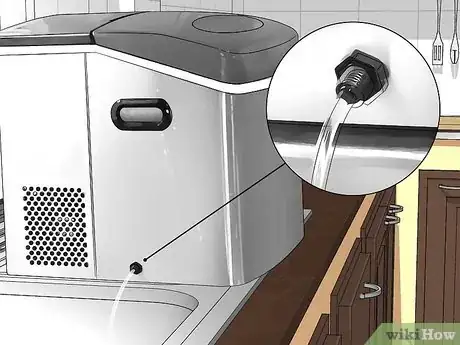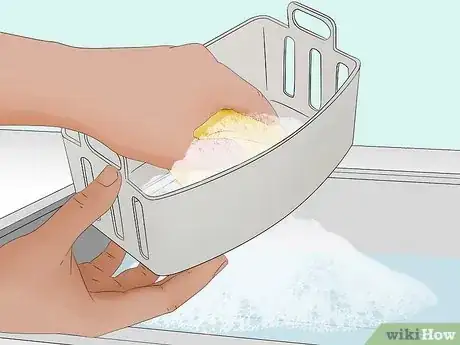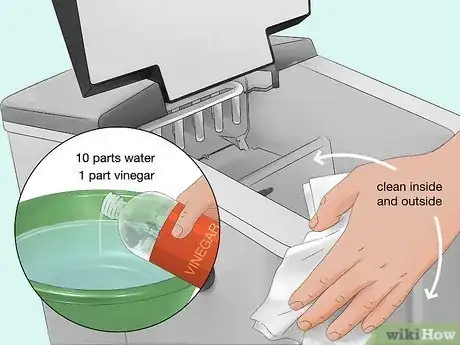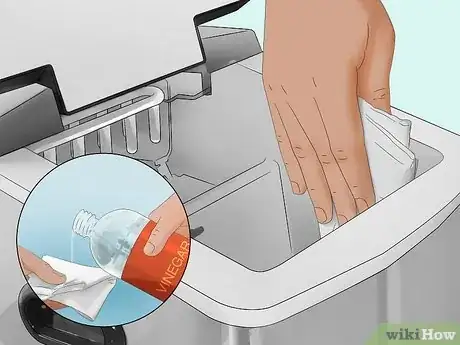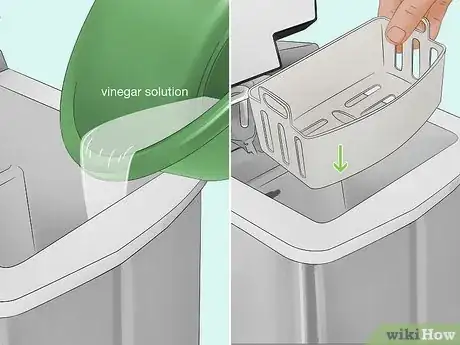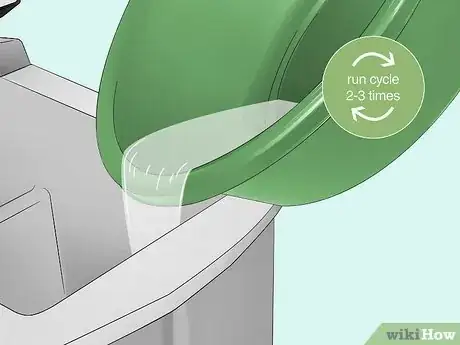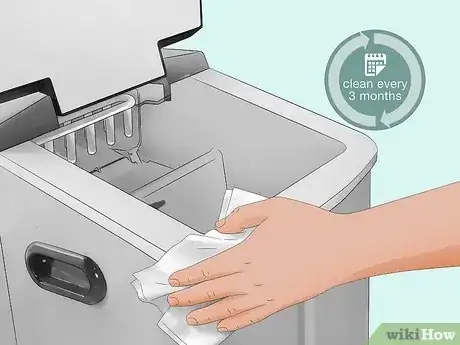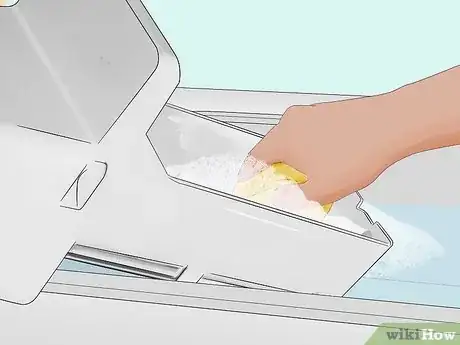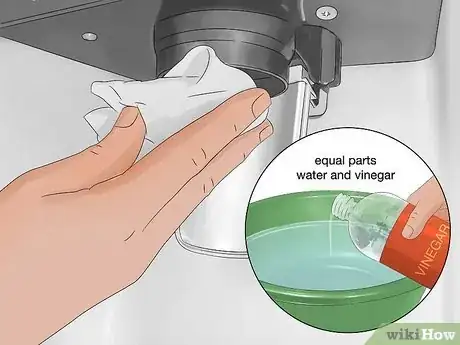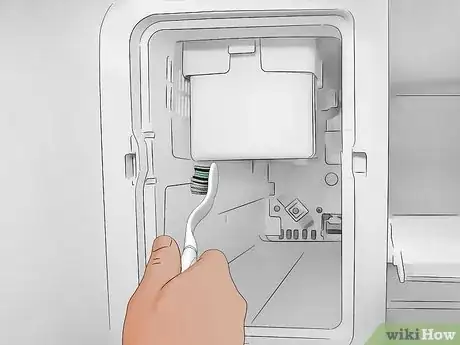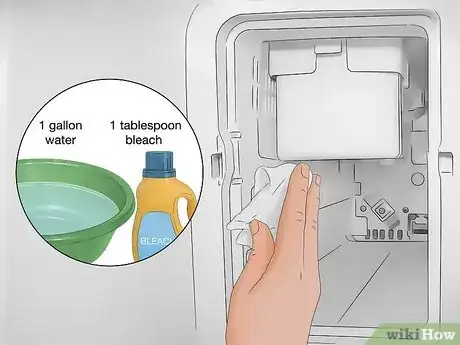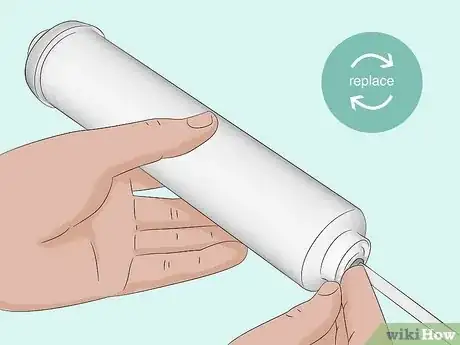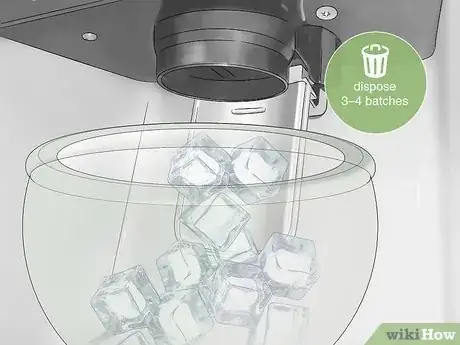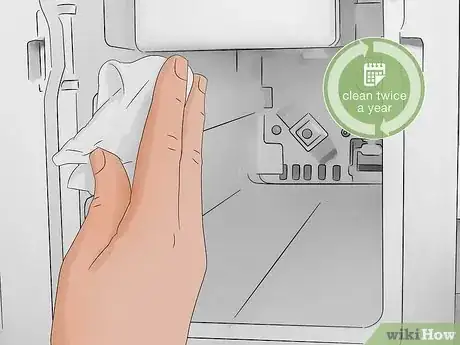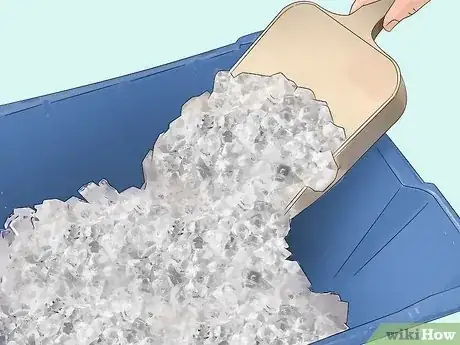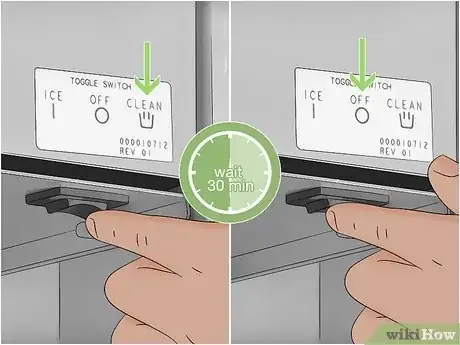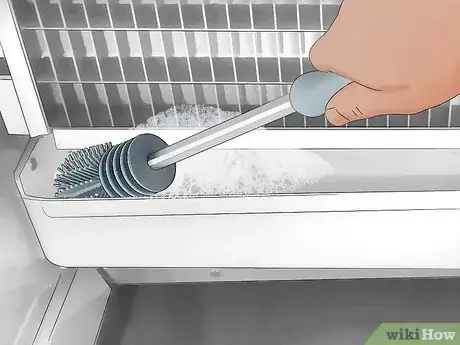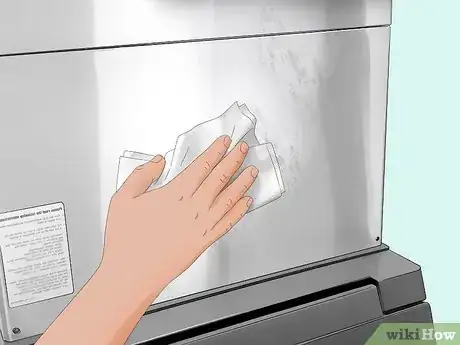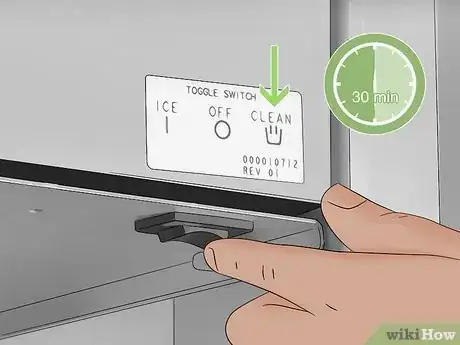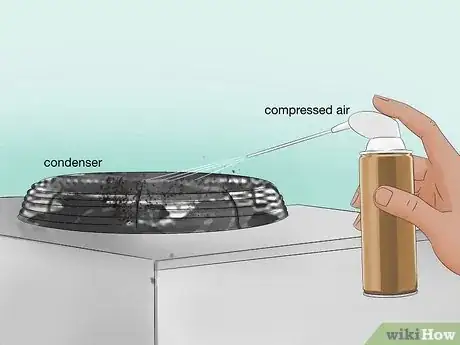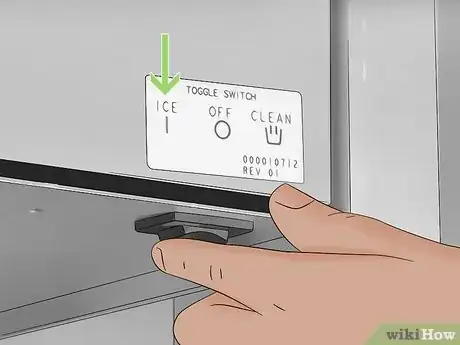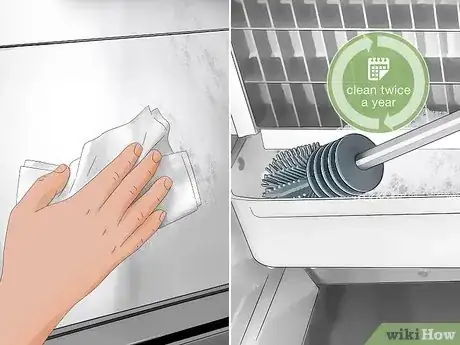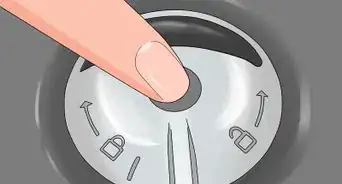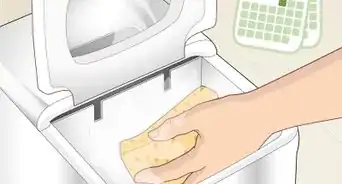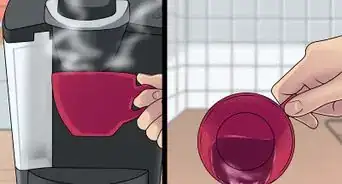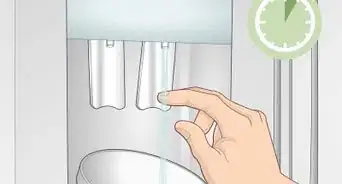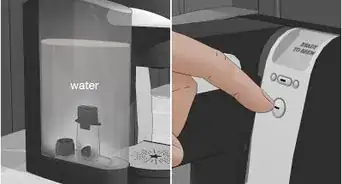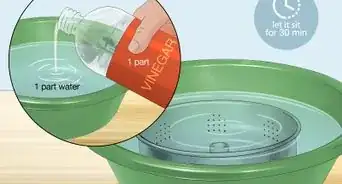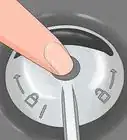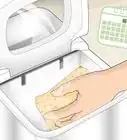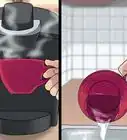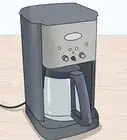This article was co-authored by Margaret Maragh and by wikiHow staff writer, Hunter Rising. Margaret Maragh is a Green Cleaning Expert based in New York City. With over 11 years of experience, Margaret and her team at Eco-Friendly Green Cleaning specialize in using environmentally friendly products for deep cleaning services. Margaret has also created a plant-based, unscented, all-purpose cleaner to further support the mission of using eco-friendly cleaning supplies in her work.
There are 26 references cited in this article, which can be found at the bottom of the page.
This article has been viewed 5,161 times.
Ice makers are a major convenience in your kitchen, but they still build up dirt and grime like any other appliance. If you want to keep your ice cubes fresh, cleaning your ice maker is an easy chore you can finish in less than an hour. Keep reading to learn how to clean, descale, and disinfect countertop ice machines, ice makers in your freezer, and commercial ice machines.
Things You Should Know
- Use vinegar and water or a commercial sanitizer to clean a countertop ice machine. Give these a thorough clean every 3 months.
- Clean a freezer ice maker with bleach and water. Replace the fridge water filter and scrub down the ice basket with soapy water.
- Use a commercial sanitizer and run the "clean" cycle to clean out a commercial ice maker.
Steps
Cleaning Countertop Ice Machines
-
1Unplug and drain your ice machine. Dump out or use any ice that’s still left in the machine. Disconnect your ice machine from power so it doesn’t run while you’re trying to clean it. Look for the white drain cap on the bottom or side of the machine. Hold the machine over your sink and pull out the drain plug to get rid of any water that’s inside. Once the ice machine is empty, put the drain plug back on.[1]
- Some drain plugs have a small rubber stop underneath the cap. Pull out the rubber stop to let the water drain out.
-
2Wash the ice bucket and scoop with dish soap and water. Open your ice machine and pull up on the handles inside to remove the basket and the scoop. Wet a washcloth with some warm water and a few drops of dish soap and use it to scrub the entire basket. Leave the bucket out to air-dry while you clean the rest of the machine.[2]
- Instead of using dish soap, you clean the basket with a solution that’s 1 part vinegar and 10 parts water, or 1 part baking soda to 5 parts water.[3]
Advertisement -
3Wipe the machine with a vinegar-water solution. Make a cleaning solution with a 10:1 ratio of water to vinegar, like 1 tablespoon (15 ml) of vinegar and 2⁄3 cup (160 ml) of water. Wet a microfiber cloth with your cleaning solution and the inside and outside of the machine. Be sure to scrub the bottom really well since that’s where the machine holds water.[4]
- As an alternative, you can substitute lemon juice for vinegar in your cleaning solution.
-
4Clean tough scale or stains with undiluted vinegar. If there’s still residue inside your ice machine after you wipe it down, wet the corner of your cloth with pure vinegar and scrub the area to descale it. Rewet the towel as it dries out and keep rubbing at the scale until it comes off.[5]
-
5Scrub the prongs and hard-to-reach areas with a silicone brush. Dip a silicone cleaning brush in your vinegar solution and work it into the corners of the ice machine. Find the prongs on top of your ice machine where the ice cubes form, and scrub between them with your brush.[6]
- In a pinch, you can use an old toothbrush to scrub the surfaces.
-
6Make a batch of ice with the vinegar cleaning solution. Pour whatever you leftover of your cleaning solution into the bottom reservoir before putting the bucket back in. Plug your ice machine back in and let it run through a full cycle of making ice out of the solution. Once the machine finishes making cubes, dump them out and drain any leftover solution from the reservoir.[7]
- Running your vinegar solution through the machine helps break up any residue inside the machine.
-
7Disinfect your ice maker with a commercial cleaner. To kill any bacteria that’s inside your ice maker, pour a commercial ice machine cleaner with sanitizer and descaler into the reservoir. Let a full freezing cycle run through the machine before draining the solution out.[8]
-
8Run water through the machine 2–3 times to remove leftover cleaner. Fill the reservoir with clean water and let the machine run through a full cycle. Since there might be leftover vinegar solution in the machine, dump the cubes out once they’re finished. Run your ice machine and get rid of the cubes at least one more time to completely flush it.[9]
- Any ice cubes from the first 2 or 3 batches could have an unpleasant vinegar aftertaste.
-
9Try to clean your ice machine every 3 months. You only need to clean your ice machine when you start seeing buildup, which usually takes a few months. You may need to clean your ice machine more frequently if you have hard water since scale will build up faster inside.[10]
- Replace the water in the machine every day so your ice cubes stay fresh.
Cleaning Freezer Ice Makers
-
1Turn off the ice maker in your freezer. If your fridge has an ice dispenser, look for an “Off” button for your ice maker. Otherwise, open your freezer and look for a metal or plastic level on the ice maker. Lift the handle to turn off the ice maker so it doesn’t run while you’re cleaning.[11]
- If your ice maker doesn’t have an off switch, then unplug your fridge while you’re working so the ice maker doesn’t run. Cleaning only takes about 20 minutes, so your food will still stay cold and safe.
-
2Wash the ice bin with dish soap and let it dry. The ice bin will easily pull out from your freezer when you pull on the handle. Dump any leftover ice into your sink to get rid of it. Wet a microfiber cloth with warm water and add a few drops of dish soap. Wipe the ice bin thoroughly before rinsing it off with clean water.[12] Leave the bin out to air-dry completely while you clean the ice maker in your freezer.[13]
- Instead of dish soap, you could use a solution made from equal parts water and white vinegar.
-
3Clean the ice tray and dispenser with a water-vinegar solution. Mix equal parts of white vinegar and warm water in a bowl. Dip a microfiber cloth or a sponge into your cleaning solution and wipe the entire ice maker down. Be sure to wipe off the dispenser if your fridge has one since there could be some buildup there as well.[14]
- If there’s ice frozen on the spot you’re trying to clean, wet a cloth with warm water and rub it against the ice to help it melt and break apart.
-
4Descale stubborn areas with a toothbrush. Bust out an old toothbrush and wet it in your vinegar cleaning solution. Focus on cleaning the tight spots and small areas where scale easily builds up, such as the corners of your ice maker and the tray where the ice freezes.[15]
- Wipe off any residue that you scrub off with a clean, damp cloth so it doesn’t get into any new ice cubes.
-
5Disinfect your ice maker with a water and bleach solution. Mix 1 tablespoon (15 ml) of bleach with 1 gallon (3.8 L) of water to dilute it. Dip a cloth in the solution and wipe the inside of the ice bin and ice maker. Make sure you rinse the cleaner off with a damp cloth so there isn’t any bleach left on the ice maker.[16]
- Germs can build up near the ice dispenser on the front of your freezer, so be sure to wipe that down too.
-
6Replace the water filter in your fridge. All the water that goes into your ice maker runs through the filter, but the filter becomes less effective as it ages. Get a new water filter that’s made for your fridge model from a hardware store or online. Change the water filter that’s inside or at the bottom of your fridge.[17]
- Plan on changing your water filter at least 2 times a year, but you may need to do it more frequently if you have hard water.
-
7Put the ice bin back in your freezer and turn the ice maker on. Once the ice bin is completely dry, slide it into the ice maker in your freezer. Press the “On” button on your ice maker, flip the lever up, or plug your fridge back in to run your ice maker again.[18]
-
8Get rid of the first 3–4 batches of ice cubes. There might be a little leftover grime or cleaning solution on your ice maker when you first turn it on and it could get into the cubes. After the ice maker cycles through a few times, pull out the bin and empty the cubes into your sink.[19]
-
9Clean your ice maker twice a year. It takes a little while for scale and grime to build up in an ice maker, so you only need to clean it out a couple of times each year. However, you may want to empty the cubes in your ice bin if they melt together or if you haven’t used any ice in a few days.[20]
- Ice cubes may start to develop an unpleasant flavor the longer they’re in your freezer.
Cleaning Commercial Ice Machines
-
1Remove all of the ice from the ice machine. Use your machine’s ice scoop to take all of the ice out of the machine. You can keep the ice in a sealed bucket and keep it in a large freezer, or you can dump the leftover ice in the sink. Find the power switch for your ice machine and turn it off so the rest of the ice can melt.[21]
- If ice cubes are frozen together at the bottom of the bin, hit them hard with the edge of the scoop to break them apart.
-
2Run the “Clean” cycle on your ice machine with a commercial cleaner. Flip the power switch to the option marked “Clean” or “Wash” and let the machine run until it asks you to put in cleaner. Follow the manufacturer's instructions for your ice machine to add the correct amount of commercial cleaner into the water trough. Let the machine run for a full clean cycle, which usually lasts 20–30 minutes before turning it off again.[22]
- Avoid using bleach or any other abrasive cleaners since they could damage the components inside your ice machine.
-
3Scrub the ice machine components with cleaner and a nylon brush. Mix commercial ice machine cleaner and water in a sink following the recommended amount from the manufacturer. Remove as many components from inside your ice machine as you can and let them soak in the cleaner for a few minutes. Then scrub them with a nylon cleaning brush to remove grime and scale. Dip the brush in your cleaner and scrub the inside of the ice bin as well.[23]
- Rinse all of the components and bin with clean water to rinse the cleaner off.
-
4Wipe the outside of the machine with soapy water. Get a microfiber cloth wet and add a few drops of dish soap. Wipe the outside of the machine and the handles with the soapy water to kill any germs on the outside.[24]
- If your ice machine is made of stainless steel, then use a stainless steel cleaner on the surfaces.
-
5Run a clean cycle with commercial sanitizer to disinfect the machine. An ice machine sanitizer kills all of the germs that are deep inside your machine. Turn your machine on to the “Clean” cycle again and add the sanitizer into the water trough. Let the machine run through a 20–30 minute cycle so the sanitizer works through the system and drains out.[25]
- Manufacturers recommend different amounts of sanitizer for each machine, so check your instruction manual to know exactly how much to use.
-
6Turn off the machine to clean the condenser and filter with compressed air. Turn the ice machine off and unplug it from power. Take off the panel on the top or side that has the condenser and filter inside. Use a bottle of compressed air to spray all of the dirt and dust off of the condenser and filter so they’re clean.[26]
- The condenser and filter cool your ice machine down to freeze water, so it’s important to keep them clean so they function properly.
- You can use a vacuum instead of compressed air.
-
7Turn your ice machine back on. Plug your machine back in and flip the switch to the “On” or “Ice” position. You’ll be able to use the first batch of ice cubes as soon as they’re finished freezing since the cleaner and sanitizer have worked through the system.[27]
-
8Clean commercial ice machines every 6 months. Cleaning twice a year ensures that the ice in the machine is safe to use and free of bacteria. If you have hard water, you may need to clean your ice machine a month or two sooner.[28]
Things You’ll Need
Cleaning Countertop Ice Machines
Cleaning Freezer Ice Makers
Cleaning Commercial Ice Machines
Expert Interview
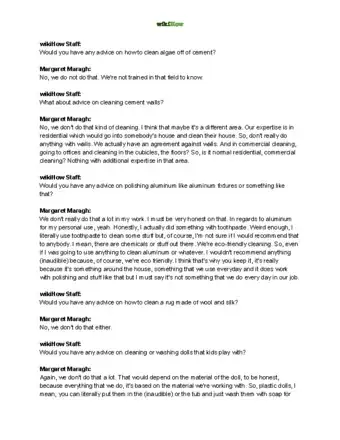
Thanks for reading our article! If you'd like to learn more about cleaning an ice maker, check out our in-depth interview with Margaret Maragh.
References
- ↑ https://pdf.lowes.com/productdocuments/ec760754-2480-470e-9ca8-08989f469f02/10494226.pdf
- ↑ https://files.bbystatic.com/8cutA8hRJJH7sFs9Y9IWEw%3D%3D/NS-IMP26SL0_19-0036_QSG_V1_EN_Final_lr.pdf
- ↑ https://www.whynter.com/user-manual/IMC-270MB-Whynter-Compact-Portable-Ice-Maker-27%20lb-capacity.pdf
- ↑ https://youtu.be/NORLXKSlTGk?t=42
- ↑ https://youtu.be/NORLXKSlTGk?t=58
- ↑ https://youtu.be/TWtZlmjnZLo?t=257
- ↑ https://youtu.be/NORLXKSlTGk?t=77
- ↑ https://youtu.be/TWtZlmjnZLo?t=116
- ↑ https://youtu.be/TWtZlmjnZLo?t=415
- ↑ https://www.whynter.com/user-manual/IMC-270MB-Whynter-Compact-Portable-Ice-Maker-27%20lb-capacity.pdf
- ↑ https://www.crosley.com/uploads/1/0/8/1/108167455/cfeh272usecareguide.pdf
- ↑ https://www.bobvila.com/articles/smelly-fridge/
- ↑ https://www.crosley.com/uploads/1/0/8/1/108167455/cfeh272usecareguide.pdf
- ↑ https://www.thekitchn.com/5-things-to-know-about-cleaning-your-built-in-ice-maker-246479
- ↑ https://cleanzen.com/blog/how-to-clean-ice-maker/
- ↑ https://www.thekitchn.com/5-things-to-know-about-cleaning-your-built-in-ice-maker-246479
- ↑ https://www.consumerreports.org/home-maintenance-repairs/filters-you-should-be-changing-at-home-a7259829473/
- ↑ https://www.crosley.com/uploads/1/0/8/1/108167455/cfeh272usecareguide.pdf
- ↑ https://cleanzen.com/blog/how-to-clean-ice-maker/
- ↑ https://cleanzen.com/blog/how-to-clean-ice-maker/
- ↑ https://youtu.be/ltf4nehxskk?t=44
- ↑ https://youtu.be/byNkp24rKrQ?t=190
- ↑ https://www.iceomatic.com/getattachment/servicesupport/Cleaning-ICE.pdf?lang=en-US
- ↑ https://static.globalindustrial.com/products/pdf/89275-procare-plus-ltd-shanghai/243032.pdf
- ↑ https://www.iceomatic.com/getattachment/servicesupport/Cleaning-ICE.pdf?lang=en-US
- ↑ https://itvice.com/cd/docs/spika/itvice_sng_mant_en.pdf
- ↑ https://youtu.be/ltf4nehxskk?t=219
- ↑ https://youtu.be/exnNEhaBE5o?t=30
- ↑ https://www.thekitchn.com/get-rid-of-bad-freezer-smells-23063980
